Pinning down the muon (g-2) anomaly at the CERN SPS
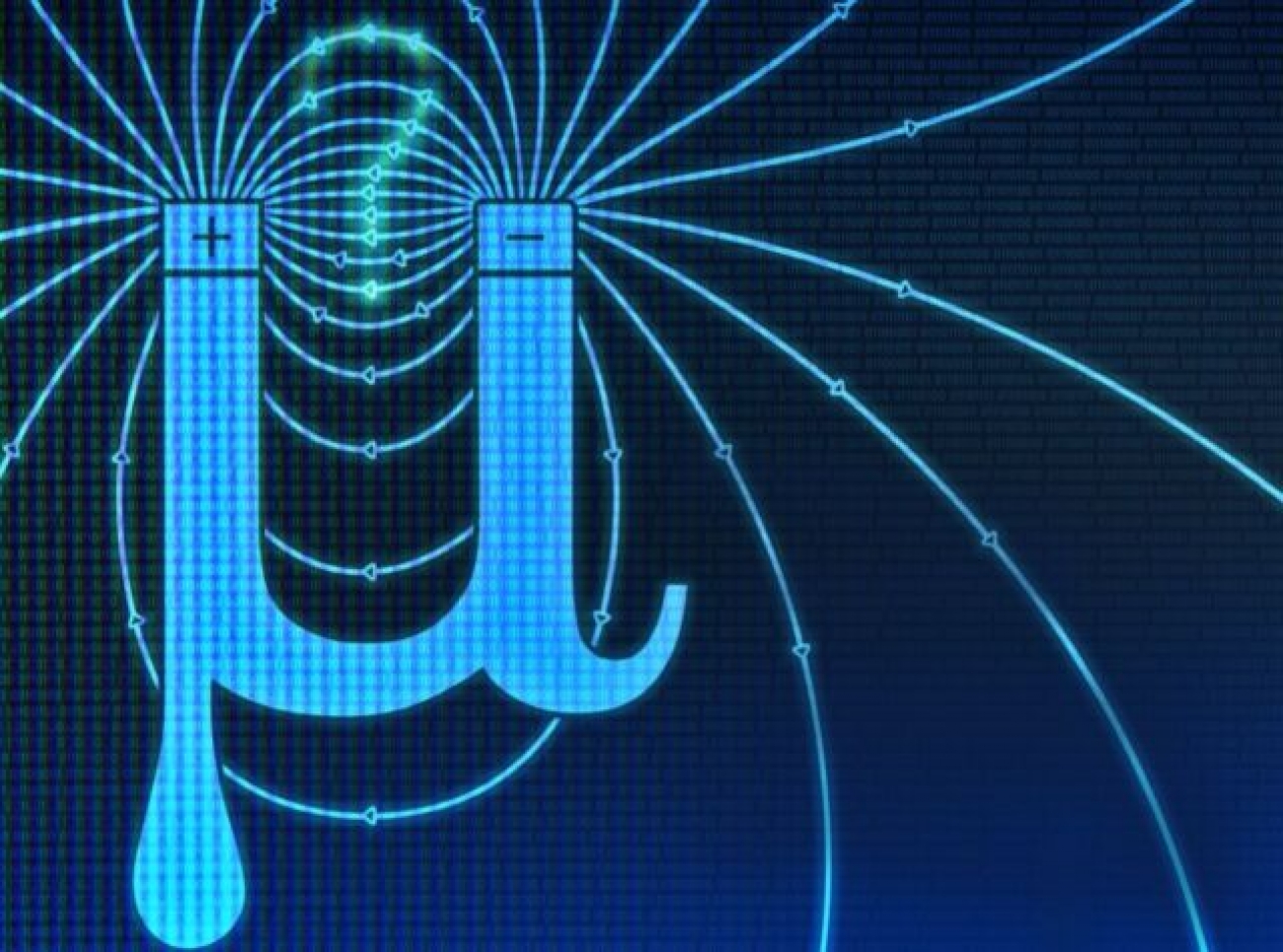
The Dirac equation predicts the muon gyromagnetic ratio g=2. Loop effects from quantum field theory lead to a small deviation from this value, parameterized by the so called anomalous magnetic moment which is defined as aμ=(g-2)/2. The difference between the theoretical prediction and the experimental value remains one of the long standing puzzles in the Standard model (SM) of particle physics. The latest results from the Fermilab experiment Muon g-2 have confirmed this discrepancy [1]. The combination of its latest experimental results at Fermilab together with its first measurement at Brookhaven (BNL E821) lead to a difference with the theoretical value [2], Δaμ = aΕxpμ-aTheoμ=(211± 59)10-11, at the 4.2 σ level.
This has motivated a worldwide experimental and theoretical effort towards understanding the origin of this discrepancy. Indeed, we are now facing the era where experimental and theoretical uncertainties are comparable.
At M2 beamline of the CERN SPS two approaches are being pursued to elucidate this discrepancy. From one side, MuonE experiment will address this problem from the Standard Model perspective while the NA64μ experiment will approach these from a different perspective, trying to elucidate if the g-2 anomaly originates from new physics beyond the SM. Interestingly, introducing the latest Lattice QCD calculations in the average theoretical prediction would reduce the discrepancy below 2σ [3].
The MuonE experiment
The MuonE, previously presented in EP newsletter [4,5] is an experiment aiming at helping in understanding the long-standing discrepancy between the experimental value and the Standard Model (SM) prediction of the anomalous magnetic moment of the muon, aµ, which remains one of fundamental parameters in Quantum Field Theory that still lacks an explanation.
The new measurement from the Muon g-2 experiment at Fermilab diverges from theory with the most precise measurement to date while also confirmed the previous measurement obtained at the BNL [6] a decade ago. Another new fact is that the Hadronic Leading Order contribution to g-2 has received a sizeable consistent progress in the lattice QCD evaluations (LQCD).
In a series of papers appeared showing the calculations of various collaborations [7] the tension is significantly decreased.
The Budapest-Marseille-Wuppertal collaboration has shown [8] a difference of the lattice QCD result with respect to the experiment (see BMW -Nature 2021) of 1.5 σ. In Fig. 1 (from [9]) the comparison between the new measurement from Fermilab g-2 experiment and the two different theoretical calculations is shown.
The present Δaμ discrepancy may be due to missed contributions in the leading hadronic contribution to aμ obtained by the dispersive approach may show to be different from lattice.
In this new situation, the alternative approach as the one proposed with the MuonE experiment may provide a crucial independent determination, because it can measure [4,5] Δaμ experimentally which, as a fact, does correspond to the very same function as the one calculated by the LQCD.
The Covid19 pandemic unfortunately slowed down the preparation of the test run on the M2 beam assigned to MUonE by the SPSC committee. The consequence is that at the end of 2021 MUonE will have only 1 station instead of the foreseen 3. The calorimeter is progressing well, so the very first test step will be the commissioning of a tracking station followed by the calorimeter (6 PbWO4 crystals being assembled and tested in Padova). The measurements planned for 2021 will be postponed to 2022, when all 3 stations will be available.
The MUonE project has entered in a phase where the important demonstration of the feasibility of a such a precise measurement must be provided, in the aim to support one or the other theoretical calculation which at the moment give slightly different predictions.
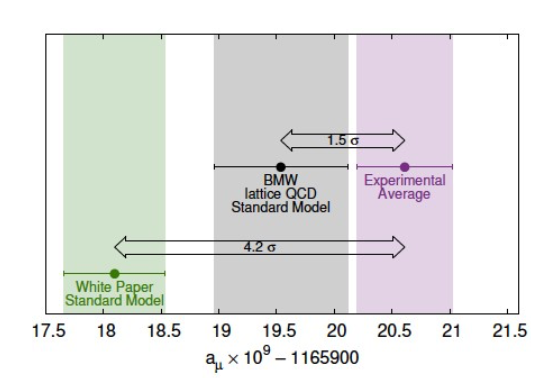
Figure 2: The present experimental status, compared to theory expectations from [7] and [10].
The results from the first tests of the MUonE experimental apparatus in 2021 and 2022 will be crucial to demonstrate the feasibility of this experiment.
The NA64μ experiment
The NA64μ experiment will approach these searches from a different perspective, trying to elucidate if the g-2 anomaly originates from new physics beyond the SM. A minimal extension of the SM able to explain the mismatch between the SM theory prediction and the experimental measurement, consists in the addition of a new very weak interaction between the standard matter and a dark sector. The existence of dark sectors is also strongly motivated as framework to explain the origin of DM as a thermal freeze-out relic, a similar mechanism to the Weakly Interacting Massive Particle (WIMP), but in a broader and lower mass range [11].
The mediator of this force may be a massive vector boson, a dark photon, associated to a U(1) gauge symmetry. The dark photon couples kinetically to the standard photon, γ-A’, with mixing strength ε of the order of 10-3-10-5. This interaction can give via loop effects the required additional contribution to explain the anomaly [12]. Dark photons can be searched in fixed target experiments such as NA64e, where a high energy beam collides with an active target producing a dark photon. Depending on its mass it will decay visibly to a pair of leptons, or invisibly to a pair of DM particles (see Fig. 3):
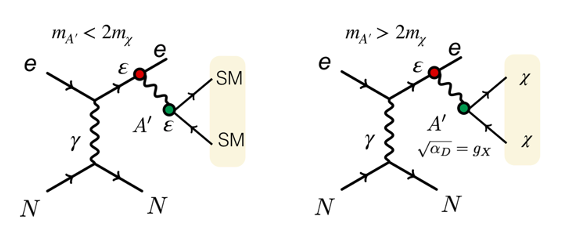
Fig 3: Visible (left) and Invisible (right) Dark Photon decay modes after being produced in the scattering off a high electron energy beam with a target.
NA64e has been taking data since 2016 until 2018 accumulating 2.84 x1011 electrons on target (EOT) and will resume data taking this year (see EP newsletter for more details). In the presence of light dark states, A’ would decay predominantly invisibly to dark matter particles candidates leaving missing energy as signature in the experiment. Together with Babar experiment [13], NA64e ruled out the dark photon purely invisibly decay as explanation of (g-2)μ [14], as it is shown in Fig 4 Left.
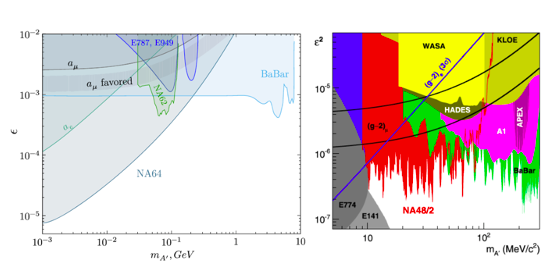
Fig 4: Left: Constraints from NA64 2016-2018 combined analysis in the (mA’, ε) plane compared to previous constraints and to the favoured area by (g-2)μ and by (g-2)e [15]. Right: Exclusion limits from different experiments in the (mA’, ε) plane for a dark photon hypothesis decaying purely visibly compared to the favoured area by (g-2)μ and by (g-2)e [9].
The other case, in which A’ is the lightest state and decays purely visibly to standard model particles has been constrained by several experiments being completely excluded as explanation for the anomaly by NA48 experiment [16] (see Fig. 4 right). However, recently, it has been proposed an alternative scenario. In the case where mA’ >> mχ1>> me, the dark sector states could exhibit off-diagonal interactions with the dark photon, resulting in two different masses dark states χ1 and χ2 [17]. The heavier eigenstate, χ2, can decay into the lighter state χ1 and an off-shell dark photon which can then decay visibly to SM particles (see Fig. 5). We refer to this signature as semivisible channel. It can still explain the (g-2)μ anomaly and evade these experimental constraints [18, 19, 20], since pure visible and invisible modes are suppressed. In addition, χ1 is stable in this model and forms the thermal dark matter component in the universe, recovering also the DM thermal freeze-out explanation [16]. NA64e has currently performed a first analysis of the experiment sensitivity to this decay parameter space (see further details on P. Crivelli, EP CERN seminars 25th May 2021).

Fig 5: Schematic diagram of the dark photon semi-visible decay [11].
Another possibility to explain this discrepancy with the SM value, foresees the existence of a new light Z’ vector boson which predominantly couples to the second and third generation of leptons (Lμ−Lτ models) and decays subsequently to a pair of neutrinos or DM particles [20]. These bosons can be produced in e+e- colliders and the BABAR results excluded this possibility for mZ’> 2mμ . Recently, the first constraints by Belle II running at SuperKEKB in Japan, for Ζ’ masses below the muon mass were reported [21] and could be improved by the increased integrated luminosity. If such boson exists, it can be also produced in the muon scattering process μ-+Ζ μ-+Ζ+Ζ’ after a high energy muon beam impinges on a target, as shown in Fig. 6
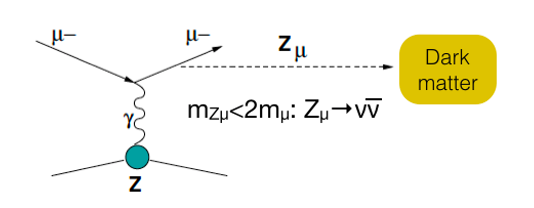
Fig 6: Production and subsequent Z’ decay in the collision of a high energy muon beam with a target.
NA64μ experiment [22] aims to search for these invisible Z’ decays using the 160 GeV M2 beam line at the CERN SPS. A similar experiment, M3, is also under consideration at Fermilab [23]. The Z’ would be produced in the Bremstrahlung reaction after a high energy muon beam collides with an active target, an electromagnetic calorimeter. In this case, the signature will be missing momentum. A fraction of the primary beam energy will be carried away by the scattered muon which momentum will be measured by a set of trackers after being deflected by a magnet located downstream the target. A signal like event would be identified by a single muon in the final state with half beam energy.
Α pilot run is planned in the fall of 2021 to study the feasibility of the technique. Assuming that the preliminary measurements and projection of the simulation in terms of beam quality, beam halo properties, hadron contamination, momentum reconstruction accuracy, trigger rate are confirmed the first physics run of the experiment is foreseen in 2022. The goal is to accumulate 1011 muons on target (MOT) which would allow to probe the region of parameter space suggested by the (g-2)μ. In Fig. 7 left is illustrated the projected sensitivity for the experiment after accumulating 1012 muons on target (MOT). The red region represents the favoured region by the anomaly. In addition, if this type of interaction, through an Lμ−Lτ current, exists it may also induce at one loop level γ-Z’ interactions which can be observed with NA64e motivating the synergies and complementarities between both experiments to fully cover these searches. Moreover, the experiment will be also sensitive to dark photons in a mass region larger than 0.1 GeV, which is not accessible with NA64e, thus, allowing to completely explore the thermal light dark matter parameter space with both experiments [24].
The restart of the CERN accelerator complex is bringing very exciting times ahead of us! Developments in both the theoretical and experimental side will be crucial to solve this very intriguing puzzle and understand if this is really a hint for New Physics.
Note: Cover image by Daniel Zemba, Penn State, All Copyrights Reserved by the artist.
References
[1] B. Abi et al. Muon g-2 collaboration Phys. Rev. Lett. 126, 141801
[2] T. Aoyama et al. Phys. Rept. 887 (2020) 1-166
[3] S. Borsanyi et al. Nature 593 (2021). doi:10.1038/s41586-021-03418-1.
[4] Letter of Intent, CERN-SPSC-2019-026 / SPSC-I-252 5/06/2019.
[5] G. Abbiendi, C.M. Carloni Calame, U. Marconi, C. Matteuzzi, G. Montagna, O. Nicrosini, M. Passera, F. Piccinini, R. Tenchini, L. Trentadue, G. Venanzoni, Eur. Phys. J. C 77 (2017) no.3, 139
[6] G.W. Bennet et al., Phys. Rev. D73 (2006) 072003.
[7] P. Banerjee, C.M. Carloni Calame, M. Chiesa, S. Di Vita, T. Engel, M. Fael, S. Laporta, P. Mastrolia, G. Montagna, O. Nicrosini, G. Ossola, M. Passera, F Piccinini, A. Primo, J. Ronca, A. Signer, W.J. Torres Bobadilla, L. Trentadue, Y. Ulrich, G. Venanzoni, Theory for muon-electron scattering@ 10 ppm, European Physical Journal C, vol.80,6,1
[8] Borsanyi, S. et al. Preprint at https://arxiv.org/abs/2002.12347 (2020) and Nature (2021).
[9] Zoltan Fodor seminar at KAVLI-IPMU, 19 May, 2021.
[10] T. Aoyama et al, arXiv:2006.04822, Phys. Repts. 887 (2020) 1-166.
[11] G.Lanfranchi, et al., arxiv:2011.02157
[12] M. Pospelov, Phys. Rev. D 80, 095002 (2009).
[13] BaBaR collaboration, Phys. Rev. Lett. 119, 131804 (2017)
[14] NA64 collaboration, Phys. Rev. Lett. 118, 011802 (2017)
[15] NA64 collaboration, Phys. Rev. Lett. 123, 121801 (2019)
[16] J. R. Batley et al. (NA48/2 Collaboration), Phys. Lett. B 746, 178 (2015).
[17] E. Izaguirre, et al. PRD 96, 055007 (2017)
[18] G. Mohlabeng, PRD 99, 115001 (2019)
[19] Y. Tsai, et al., PRL126, 181801 (2021)
[20] S.Gninenko et al. arXiv:2003.07257
[21] I. Adachi et al., Phys. Rev. Lett. 124, 141801(2020)
[22] D. Banerjee et al. [NA64 Collaboration], "Addendum to the proposal P348: Proposal for an experiment to search for dark sector particles weakly coupled to muon at the SPS”. CERN-SPSC-2019-002 / SPSC-P-359, January 14, 2019.
[23] Y. Khan et al., arxiv:1804.03144
[24] S.Gninenko et al. PLB796, 117 (2019)
